Features to Consider
It can be overwhelming to buy a thermal camera or a thermal imager, today.
This is because the specifications and capabilities of thermal imaging devices vary greatly, and there are a lot of models to choose from.
Prices vary widely, too. You can pay anywhere from $200 to $20,000+ for one.
The best way to make a smart selection is to take 3 minutes to understand the most common features available in thermal imaging devices today, before making your selection.
Once you understand what these key features actually mean to you, it'll be easy to find the right one for your needs.
Camera or Imager?
The first thing to consider is whether you need a real thermal camera, or just a real-time thermal imager.
If all you need to do is view the temperature of something in real time - and you don't need to store the image for later - then you will be happy with a thermal imager.
A thermal imager provides live temperature readings of the object you are viewing through the unit, but it does not store images. Thermal imagers are perfect for checking for hot spots on equipment & construction sites, during routine maintenance visits.
On the other hand, if you need to capture and store images to share with others or process later on, then you want to buy a thermal camera, also called an IR camera, an infrared camera or a thermal imaging camera.
Thermal cameras store images and/or video on a local SD card or other onboard storage. In addition, some thermal cameras offer the option of superimposing a thermal image onto a live digital photograph of the same object, to help with identifying issues.
NOTE: Whether you buy a thermal imager or a camera, pay special attention to whether the device is equipped with Bluetooth or WiFi connectivity. Network connectivity makes it possible to transfer images to another device in real time, thus eliminating or minimizing the need for native onboard storage.
Smartphone or Handheld?
Today, there are two basic formats of infrared thermal cameras.
You can purchase a smartphone thermal camera attachment like the popular FLIR One, or choose from more proven, higher-end handheld thermal camera made by leading manufacturers, FLIR and Fluke.
Smartphone thermal cameras like the FLIR One and Seek Compact XR offer incredible value and convenience, but the temperature range and image resolution of these units can be limiting.
For most professional applications, you'll want to purchase a handheld thermal imaging camera due to the increased sensitivity, broader temperature range, and the features and options available. Handheld thermal cameras and thermal imagers come in a number of model ranges suited for different applications.
In this buying guide, we review the top-selling, best rated thermal imaging products in all of these categories.
Image Resolution
Just like a regular camera, the whole point of a thermal imaging camera is to capture a thermal image of the area or subject you are viewing, so make sure the camera resolution is precise enough for your particular need.
The larger the screen, the more detail you can see in real-time.
Imagers and cameras with larger screens often have touchscreen capabilities, as well.
Size and Weight
The size and weight of an IR camera can be an important factor if you use it frequently or have to carry it for long periods of time. Size also matters if you prefer to carry your thermal camera in a toolbox or on a tool belt.
The latest smartphone thermal cameras like the FLIR One and Seek Compact XR are incredibly popular right now, for this very reason. Both are small, lightweight and snap onto your smartphone - which makes it easy to text/transfer/store images using a device you already use, all day long.
Temperature Range & Sensitivity
A thermal camera’s temperature range and sensitivity are also critical for many applications.
Temperature Range
The camera’s temperature range tells you the minimum and maximum temperatures the camera can accurately measure.
The IR camera/imager you buy needs to cover a temperature range wide enough to accurately capture all of the objects or scenes you expect to monitor on a regular basis.
For many household inspections, a range of -4 to +220 degrees Fahrenheit (-15 to +110 degrees Celsius) is usually sufficient.
For industrial and scientific uses, and for firefighters and other emergency personnel, the required temperature range is often far wider and/or skewed into a colder or warmer range.
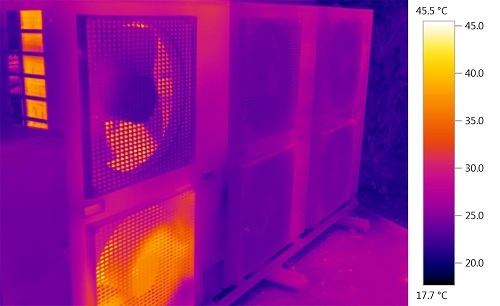
Temperature Sensitivity
A camera’s temperature sensitivity, or thermal resolution, refers to the smallest temperature difference that a thermal camera can discern between two objects.
The temperature sensitivity you need depends completely on the job you need it for and on the environment in which you're working.
For example, mechanical inspectors who need to monitor friction in rotating equipment know that a higher thermal resolution (temperature sensitivity) can make the difference between replacing a worn bearing every 5 years and replacing an entire pump, or worse.
Firefighters need to detect warm bodies within a warm environment, so they also need a higher temperature sensitivity than most.
Thermal sensitivity is measured in degrees Celsius. Inexpensive thermal sensors can detect temperature variations of one or two degrees Celsius. Higher-end units like the FLIR T420 can discern within +/- 0.045 degrees Celsius.
Image Overlay
Features such as picture-in-picture and image fusion let you overlay a visible light image onto a thermal image.
This creates a clearer and more meaningful image which is helpful in detecting heat issues in a complex space like a wiring box.
Image overlays also help to convey important information when showing thermal images to clients, customers and to your boss.
Other Features
Thermal imagers and cameras come in many different designs and offer a wide range of optional features.
Listed below are other features that may matter to you. No camera has all of the following, so make sure you note the features that are important to your particular job or application.
Bluetooth and wireless connectivity let you send images to other devices such as computers, tablets, and smartphones, and they allow for real-time streaming - all without the need for wifi or cellular coverage.
This can be really helpful in situations where multiple people need to see the images at one time, or if you lack the time or ability to upload the images in a timely manner (in the field, etc). If you work in a large team environment or use thermal imaging remotely, you will definitely want WiFi connectivity. WiFi is also required for cloud-based storage devices.
File types used to store your images matter, too. The best thermal imager cameras store images in common picture formats such as JPEG and MPEG4 video.
Lenses: many higher-end models offer wide-angle view, manual adjustable focus or autofocus lenses.
Adjustments: Reflective Temperature, Emissivity, Temperature Range, etc.
Measurement Modes: Many options here. More expensive thermal cameras can detect hot spots, let you create area boxes, display isotherm lines, identify hot/cold spots, display Delta temps, display mechanical or electrical data on screen, find the center of a hot spot and more.
Thermal Palettes: most professional thermal cameras let you select different color palettes to work within the standards of your team. For example, the FLIR T420 offers 12 palettes: Arctic, Gray, Iron, Lava, Rainbow, and Rainbow High Contrast (plus all inverted)
Picture-In-Picture: the ability to display a thermal image inside a larger visible image; or, vice-versa.
Image & Video Storage: there are several storage options, and very few thermal cameras support them all. Make sure you select the right kind for your application. The most popular storage options include:
- No Storage (live imaging only)
- Device Storage (smartphone or other)
- Micro SD
- Cloud Storage: streamed to and stored on remote servers
Image Format(s): JPEG, PNG, Radiometric JPG, GIF, RAW are the most popular.
MPEG 4 Video Recording
Video Camera w/Lamp & Laser: to assist with pointing your camera in dark environments.
Video frame rate: less expensive thermal video cameras will record video at 15Hz; live HD streaming of thermal video requires a rate of 60Hz.
Viewable Distance: how far away from your target can you take thermal readings accurately?
Field of View (FOV): how tall and wide a viewing window can be captured on film; typically measured in degrees vertical x degrees horizontal. A narrow FOV is 10-20 degrees. A wide FOV is anything over 25 degrees.
Digital Zoom: some thermal cameras offer digital zoom of 2X to 4X
Display: the size of your live on-device display; most thermal cameras make do with 2" - 5" diagonal screens.
Image annotation: ability to write notes onto a thermal image, for use later. Some cameras also offer the option of automatically adding temperature, hot spots, isothermal lines, etc.
Moveable Spot: the ability to identify hot spot(s) and track them automatically, as the camera moves.
Area Box: the ability to draw an area on-screen and measure the temperature within that area. Some cameras offer up to three simultaneous area boxes.
Image Blending: ability to merge visible and thermal images together, to create a composite image. Useful for presenting data to customers and teams.
Weatherproofing: some cameras are IP5 or IP7 compliant, suitable for outdoor use.
Battery Life: most thermal cameras can run on their batteries from as little as 2 hours up to several days.
Warranty: smartphone IR cameras are typically warrantied for one year; industrial/professional thermal cameras and thermal imagers typically carry a 2-year or 2-5-10 limited warranty.
Best Thermal Cameras for Your Smartphone
Thermal cameras are no longer limited to expensive, dedicated handheld models. They are now available as attachments for your smartphone.
The two best-selling and highest-rated smartphone thermal cameras on the market are the FLIR One for iOS and Android smartphones, and the Seek Compact for Android smartphones.
NOTE: For a deeper dive into a particular model, click on the "Review" button at the end of its review. If you want to view the latest price, click "See Latest Price".
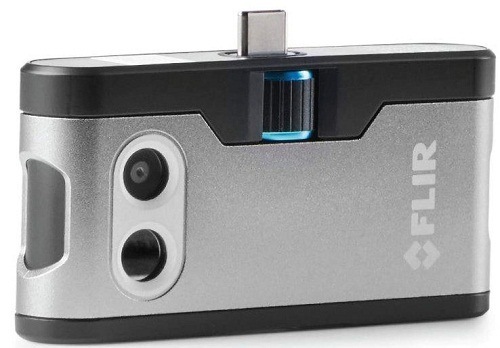
Perhaps the most well-known smartphone thermal camera, the FLIR One gives beginners and hobbyists the convenience of basic thermal imaging for a really low price.
The latest FLIR One Gen 3 introduces a OneFit adjustable connector that allows you connect the camera to your smartphone without removing the protective case.
While the FLIR One lacks the temperature range and sensitivity of a conventional handheld IR unit, it’s still a highly-capable and super-convenient thermal imager that can be used for a wide variety of tasks around the home and at work.
If the specs work for your application, then by all means buy the FLIR One - it will save you a ton of money.
Key Features
FLIR has packed lots of impressive features into a small, incredibly portable package.
- The FLIR One Gen 3 has a decent thermal image resolution
of 80x60 pixels, which can be fused with the visible camera resolution of 640x480 to create a single image that accurately displays physical details and temperature variances. FLIR calls this feature MSX technology. It makes it much easier to spot exactly which spot is unusually hot or cold.
- The temperature range of the FLIR One is -4°F to 248°F (-20°C to 120°C) which is perfect for household use, construction and some industrial applications.
- Temperature sensitivity of 0.18°F (0.1°C.), more than adequate for most applications.
- Weighing in at just 1.22 ounces and measuring 2.6 x 1.3 x 0.6 inches, the FLIR One is truly tiny, making it easy to transport anywhere you bring your smartphone.
- Available for Android and iOS smartphones.
- The FLIR One Gen 3 stores images and videos in your phone. From there's it's easy to edit and share them.
- Seven different thermal color palettes are available.
- The FLIR ONE App includes features like thermal panoramas and thermal time-lapse video.
Overall
The FLIR One Gen 3 is simple enough for anyone to use, and supports countless uses at home and work.
Nothing is as convenient as using your smartphone to search for hotspots around plumbing, circuitry, and appliances, as well as locating escaped heat around windows and doors.
Then, just text the images and notes to your contractor or yourself.
The FLIR One has plenty of work-related uses as well, allowing you to take a screenshot of an object and send it through a text message, or share larger files and videos instantly as well.
While the FLIR One may not be as powerful and detailed as its larger, more expensive cousins, it has enough resolution and image clarity to fill many needs.
The small size and smartphone connectivity make it an easy choice for anyone looking for an easy and affordable entry into thermal imaging.
FLIR ONE Upgrade Options
If the FLIR One Gen 3 doesn't quite meet your needs, here are a couple more powerful alternatives.
- FLIR ONE Pro LT - The ONE Pro LT has the same 80×60 pixels thermal resolution as the ONE Gen 3. However, it has higher thermal sensitivity and VividIR image processing that increases image quality. The ONE Pro LT also comes with its own internal battery that lasts about 1hr. It doesn't drain your battery like the FLIR ONE Gen 3.
- FLIR ONE Pro - This is the best FLIR smartphone thermal camera for pros. The high resolution (160 x 120), VividIR image enhancement and MSX technology provide a great thermal imaging experience. The ONE Pro also has a wide temperature range than the LT and Gen 3 models; -4°F to 752°F.
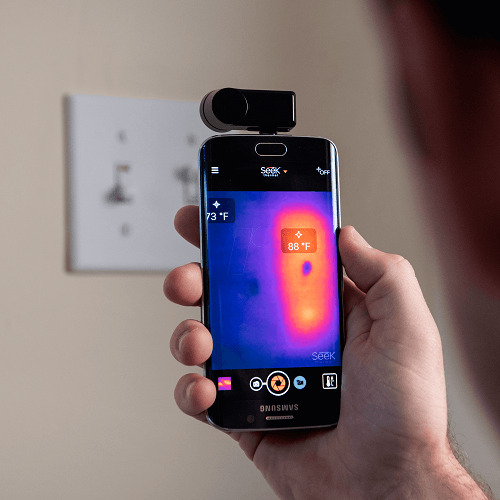
Seek’s Compact thermal camera was one of the first smartphone thermal cameras on the scene, and they continue to improve their model with each new release.
Seek’s current model is a powerful device that offers clarity and resolution well beyond what you’d expect for one this size and price.
Key Features
The Seek Compact mixes in a capable and precise thermal sensor with plenty of added features that are perfect for smartphones.
- The Compact has an impressive image resolution of 206 x 156, far better than FLIR One's resolution.
- The Seek Compact's field of view is a wide 36° (the Seek Compact XR has a narrow 20° FOV)
- The temperature range is -40°F to 626°F, quite a bit more than the FLIR One.
- Very small and lightweight, weighing just 3.7 ounces and measuring 1.6 inches long.
- A waterproof case is included that you can be attached to a keychain when not in use.
- Super-durable construction
- The included Seek Compact phone app lets you change the thermal image color palette, set temperature thresholds and adjust the location of the temperature display in the image.
Overall
The Seek Compact is an incredibly capable thermal imaging solution, given how small and inexpensive it is. It also handily beats its closest competitor, the FLIR One, on temperature range, image resolution and viewing distance.
DIY types, homeowners and others who need basic thermal imaging will appreciate how easy this unit is to use with Android and iOS devices. They may also be amazed at how precise the images are.
The super-durable construction and waterproof keychain case makes it a great choice for outdoor use, too.
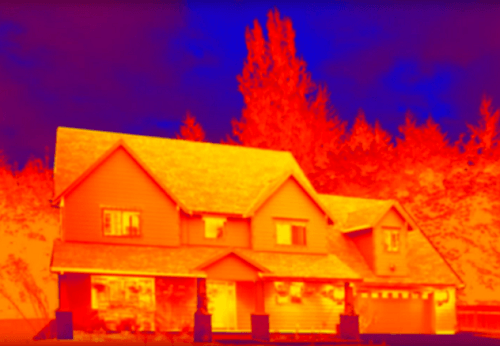
The Seek Compact does have a few limitations. For example, it takes fairly poor quality thermal images if you move the camera. That's because it has a low refresh rate of just 9 Hz. You'll need to keep your phone as still as possible.
It also lacks the handy image overlay feature of the FLIR ONE. You only get a thermal image.
Even with the blurring issue and lack of visual image overlay, the Seek Compact is an easy and affordable way to get started with thermal imaging, or simply use as a preventative maintenance tool to keep around the house.
Seek Thermal Compact Upgrade Options
Similar to the FLIR ONE, the Seek Thermal Compact has two more capable siblings that are perfect for those seeking more features and better imaging performance.
- Seek Thermal CompactXR - The CompactXR is the best smartphone thermal camera for hunting and outdoors. It's narrow field of view (20 degrees) and extra-long detection range (1800 feet), allows you to identify and track targets from afar. It has the same high resolution and wide temperature range as the Compact.
- Seek Thermal CompactPRO - The CompactPro is the best Seek Thermal smartphone camera for professionals. It boasts a high thermal resolution of 320 x 240, an 1800-feet detection range, auto & span/level Control, and adjustable emissivity.
Best Handheld Thermal Imaging Cameras
Handheld thermal imagers are the most common way to measure infrared radiation and the most powerful.
Most handheld thermal imagers are designed with a particular use in mind. As such, they vary quite a bit in terms of image resolution, temperature range, sensitivity and features. With these units, you want to start with the job you're trying to do, then match the unit to that job.
Once you pick the right camera, the hard work is over. All of the handheld imagers and cameras reviewed here are easy to operate.
NOTE: For a deeper dive into a particular model, click the "Review" button at the end of its review. If you want to view the latest price, click "See Latest Price".
1. Best Handheld Compact Thermal Camera: FLIR C5
If you want more performance and features than a smartphone thermal camera offers, but with close to the same easy portability, we recommend the FLIR C5 compact handheld thermal camera.
The C5 is part of FLIR’s compact Cx series that also includes the C2, C3 and C3-X. We’ll discuss these models briefly below. For now, let’s see what the C5 has to offer.
Key Features
The C5 combines 3 functionalities, a wide temperature range and versatile adjustable parameters into one compact package.
- The C5 has a thermal resolution of 160 x 120 pixels that delivers high quality and detailed thermal images especially from a close range.
- FLIR C5 is a 3-in-1 tool for home inspection, HVAC repair, home restoration and other professional applications. It is primarily a thermal camera. It also comes with a visual camera as well as an LED floodlight.
- The C5 comes with FLIR’s popular MSX image enhancement technology. Thanks to its dual camera design, it’s able to overlay a visual image over the thermal image, making it easier to pinpoint where the problem is.
- A wide temperature range between -4 and 752°F lets you inspect extra-cold and extra-hot surfaces. The C5 can go from inspecting a HVAC system to a car engine.
- The C5’s user interface, while not the prettiest looking, offers lots of settings and options via the 3.5” touchscreen. These include auto/manual span & level adjustment, emissivity settings, thermal palettes, spot and box temperature measurements, atmospheric temperature and others.
- The C5 is WiFi-connected. This allows you to upload images to FLIR Ignite, FLIR’s cloud storage, where you can access them at any time from any device.
- The FLIR C5 is compact and lightweight. It weighs just 6.7 ounces and measures 5.4 x 3.3 x 0.94 inches, making the C5 a truly pocket-size thermal camera.
- The FLIR C5 is designed to withstand rough environments. It has an IP54 dust and water protection and can withstand a 2m drop.
- The internal battery lasts about 4 hours. A battery life indicator on the screen tells you when it’s time to recharge it. A USB cable is included for recharging.
Overall
If you find the resolution of the FLIR One smartphone thermal camera limiting, or if you don't want to fumble around with a phone attachment, the C5 is a great alternative.
The resolution is great for most professional applications, from appliance repairs to circuitry diagnostics. We love the wide temperature range and the ability to adjust various parameters.
That said, we are not big fans of the WiFi connectivity and Ignite features. The biggest complaint from users of the C5 is that you cannot transfer images directly from the thermal camera to your phone or computer.
You have to first upload images to Ignite (which means you have to create an online account), then download them to your device. Many users encountered issues and bugs during this process, including the camera failing to upload images.
A basic thermal camera with manual data transfer via cable would have been perfectly fine.
Something else to note is that the C5’s resolution is limited for certain applications, particularly those that require a long range like hunting or home security. All you’ll see are blobs on the screen.
But the C5 is not designed for that anyway. For most pros, DIYers and home owners, it works great for their needs.
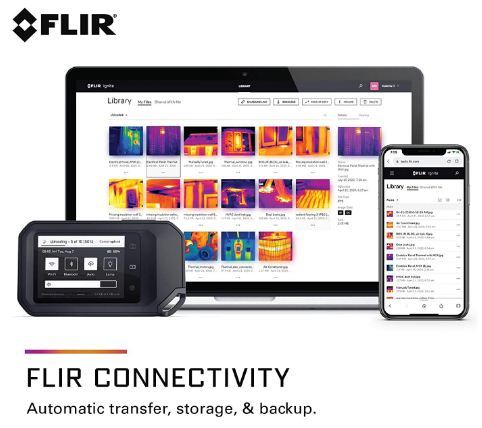
FLIR CX Series
Here are other options in the CX series.
- FLIR C2 - this is an older model that has since been discontinued, though you can still get it from some sellers on Amazon. It has an 80 x 60 resolution, a 14°F to 300°F temperature range, MSX image enhancement and a 3” touchscreen.
- FLIR C3 - the C3 is also an older product available only through third party sellers. It features a 80 x 60 resolution, 14°F to 300°F temperature range, MSX image enhancement and WiFi connectivity.
- FLIR C3-X - the C3-X is a cheaper alternative to the C5. It has a 128 × 96 resolution, a -4 to 572°F temperature range, MSX technology, and WiFi connectivity.
2. Best Value Handheld Compact Thermal Camera: Seek Thermal Revealpro
While FLIR products are great, they don't always offer the best bang for your buck. This is the case with the FLIR One smartphone cameras. Seek Thermal Compact cameras offer better value.
The same is true for compact handheld cameras. Again, Seek Thermal outdoes FLIR when it comes to value for your money.
The Seek Thermal RevealPRO is a great choice for pros, hobbyists and homeowners looking for a cheaper alternative to the FLIR C5.
- The Seek Thermal RevealPRO offers a 320 x 240 thermal resolution, double that of the FLIR C5. This means higher quality images, improved contrast between different temperatures and a longer detection range of up to 500 feet.
- The RevealPRO has a temperature range of -40°F to 626°F. It doesn't detect as high temperatures as the C5 but it can record much lower temperatures than the C5’s -4°F minimum.
- The user interface provides a variety of settings and options. These include emissivity presets, thermal palettes, manual span and level control, and spot temperature measurements using a digital reticle.
- The Seek Thermal RevealPRO lacks C5’s WiFi connectivity. But to be honest, we think that’s a good thing. Wireless connectivity in the C5 is a source of frustration for many users. By keeping it simple, the RevealPRO makes things easy.
- Thermal images are stored in an internal SD card (instead of being uploaded to the cloud), and you can transfer them to your computer using a USB cable.
- The RevealPRO weighs just 6.2 ounces and measures 7 x 3.75 x 1.75 inches, a great pocket-size thermal camera for pros on the go.
- Seek Thermal RevealPRO comes with a 4-hour rechargeable battery and has a built-in 300-lumen LED flashlight.
Overall
Like the FLIR C5, the Seek Thermal RevealPRO is by no means a high-end professional thermal camera. It’s more of an entry-level professional thermal camera for inspectors, electricians, and other pros looking for an affordable thermal camera that’s good enough for basic thermal inspections.
The RevealPRO is great for diagnosing electrical circuits, spotting insulation and moisture problems in a home, appliance repair and many other uses.
The fact that it’s small enough to fit in your pocket is a big plus.
Where we think RevealPRO could do better is the user interface. The FLIR C5 has a lower resolution but it offers a wider range of settings and options such as the ability to adjust ambient temperature, atmospheric pressure and emissivity.
We also love FLIR’s visual/thermal overlay (MSX), which is not present in the Seek Thermal RevealPRO.
Overall, the price difference isn’t that big between the two. If you prefer more options and think the MSX feature will be useful, get the C5. If you think you’ll benefit more from higher resolution or want to avoid the WiFi headaches of the C5, get the RevealPRO.

Seek Reveal Series
The Reveal Series has two additional models.
The Reveal FirePRO is designed for firefighters. It has a 320 x 240 thermal resolution and a -4F to 1,022F temperature range.
The Reveal ShieldPRO is designed for law enforcement. It has a 320 x 240 thermal resolution and an extra-long 825-yard detection range.
3. Best Budget Handheld Thermal Camera: FLIR TG165-X
If you are shopping on a budget, we recommend the FLIR TG165-X. It’s cheaper than the two compact thermal cameras we’ve reviewed above.
The FLIR TG165-X is especially suitable for pros, home owners and hobbyists looking for a gun-style thermal camera that takes quick thermal measurements of a precise area.
Key Features
- The FLIR TG165-X combines the functionality of a spot IR thermometer with that of a thermal camera. You can quickly measure the temperature of a particular spot, while also getting a thermal image to troubleshoot hot and cold spots.
- A bullseye laser lets you target a precise area. The laser appears as a ring, letting you know the size of the measurement area.
- The FLIR TG165-X has an 80 x 60 thermal sensor that can detect temperatures between -13F and 572F.
- Thermal images appear on a 2.5” screen with a 320 x 240 display resolution. Because the FLIR TG165-X has MSX image enhancement, you can choose to overlay a visual image on the thermal image to make it easier to understand what you are looking at.
- For improved precision on different surfaces, you can adjust emissivity settings to one of the three presets or select a custom value.
- The FLIR TG165-X comes with an integrated LED flashlight that’s handy when working in dark areas. The light also allows you to take visual images in low lit locations.
- The FLIR TG165-X can store up to 50,000 thermal images. A USB-C cable is included for charging and data transfer.
- The rechargeable battery lasts 5 hours without laser and 4.5 hours with the laser on.
- While it may not be pocket size, the FLIR TG165-X is still highly portable. It measures 8.3 × 2.5 × 3.2 in and weighs 13.9 ounces. It also has a rugged design with an IP54 dust and water protection and a shell that can withstand a 2m drop.
Overall
The FLIR TG165-X thermal camera is a great choice for pros who need to measure temperatures quickly and with precision. The thermal image is a nice bonus. You can see exactly where the anomalies are.
With a distance to spot ratio of 24:1, the FLIR TG165-X lets you stand a safe distance away when measuring the temperature of hazardous objects such as a moving part or a hot surface.
The thermal resolution is not the best, but it’ll do for basic thermal inspections.

FLIR TG Series
Two other popular FLIR thermal cameras in the TG series are the TG267, TG275 and TG297.
The FLIR TG267 offers a higher 160 × 120 thermal resolution and a wider temperature measurement range of -13°F to 716°F. It can also measure body temperature between 89.6F and 108.5F.
The pricier FLIR TG275 is designed primarily for automotive diagnostics and repairs. It has a thermal resolution of 160 x 120 pixels, and a temperature range between -13F and 1,022F.
The FLIR TG297 is the most expensive in the series. It is designed for industrial applications, hence it’s extra-wide temperature measurement range of -13F to 1,886F.
The FLIR TG267, TG275 and TG297 all come with bluetooth connectivity that you can use to transmit live images to the FLIR mobile app.
4. Best Handheld Thermal Camera for Pros: FLIR E6-XT
All the thermal cameras we’ve reviewed so far are suitable as hobbyist, DIY or entry-level professional thermal cameras.
For pros looking for a serious thermal camera with top-level performance and specs, we recommend the FLIR E6-XT. Of course, we are now in the thousand-dollar plus price range. So if you are shopping for a budget thermal camera, consider one of the other IR cameras above.
Key Features
- The E6-XT has a 240 x 180 thermal resolution. The high resolution means super high quality images with clear details. Whether you are looking for leaky insulation, wall studs or faulty circuitry, it’s easy to spot where the problem is using the E6-XT.
- To make diagnostics and inspections even easier, the E6-XT comes with FLIR’s MSX image enhancement. The visual and thermal image overlay makes it easier to understand what you are looking at.
- The E6-XT IR camera has an extra-wide temperature range of -4°F to 1022°F, giving pros versatility on where they can use the camera. It’s perfect for diagnosing a HVAC system as well as a home boiler or heating system.
- The E6-XT is WiFi enabled. This allows you to link it to your smartphone via the FLIR Tools app. On the app, you can download and share thermal images, as well as create and send customer reports. By the way, the thermal images retain temperature data for further analysis.
- The user interface provides access to just about any settings and options pros need. These include emissivity adjustment, color palettes, image modes, reflected temperature correction, and below/above temperature alarms.
- As for measurements, the E6-XT can take spot temperature measurements as well as min/max box measurements.
- The rechargeable lithium battery lasts about four hours. For longer work projects, you can carry an additional battery in the included case.
- As for portability, the E6-XT is not too bad. It measures 9.6 × 3.7 × 5.5 in and weighs about 20 ounces (1.2lbs).
- The E6-XT comes with an integrated LED flashlight for illuminating dark areas when doing inspections or using the visual camera.
Overall
You may be wondering why the E6-XT costs much more than IR cameras with a higher resolution. But thermal resolution is not everything in a thermal camera.
One spec that makes the E6-XT much better than other thermal camera is its thermal sensitivity, also called NETD. This is the camera’s ability to distinguish between small temperature differences.
The lower the NETD, the more contrast you’ll see in thermal images. Higher contrast produces highly detailed images, and makes it easier to spot anomalies.
The cheapest FLIR thermal cameras have a sensitivity of 100 mK or 150 mK. The FLIR E6-XT has a thermal sensitivity of less than 60 mK. For pros that need to spot tiny anomalies, this is hugely helpful.
Overall, the E6-XT is a solid choice for most professionals. It’s pricey, but it’s worth it.
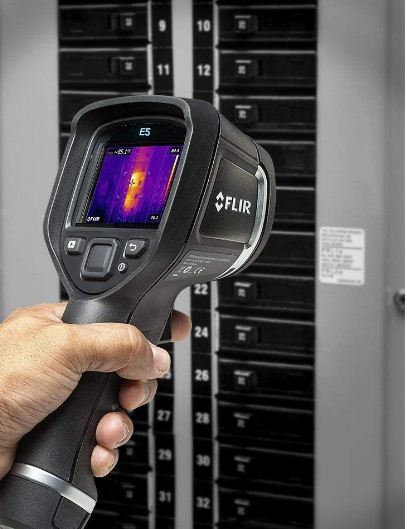
FLIR Ex Series
Looking for alternatives to the E6-XT? Here are some more professional FLIR thermal cameras in the Ex series.
- FLIR E4 - A cheaper option for pros looking for a high-performance FLIR thermal camera. The E4 has a resolution of 80 x 60 pixels, a temperature range of –4°F to 482°F, and a thermal sensitivity of about 150 mK. Also, it lacks WiFi connectivity.
- FLIR E5-XT - Another great option for pros on a budget. The E5-XT has a 160 x 120 resolution, a temperature range of -4F to 752F, WiFi connectivity, and thermal sensitivity under 100 mK.
- FLIR E8-XT - The most expensive thermal cameras in the Ex series. Great for pros that want an IR camera with high resolution and contrast. The E8-XT has a 320 x 240 resolution, a temperature range of -4°F to 1022°F, WiFi connectivity, and a thermal sensitivity under 50 mK.
5. Best Handheld Thermal Camera for Home Repairs: PerfectPrime IR0018
Coming down on the price, we have the PerfectPrime IR0018 that we think is the best handheld thermal camera for home owners doing home maintenance projects.
It’s not expensive like the FLIR E6-XT, but offers plenty of great specs including high resolution and a wide temperature measurement range.
- A 220 x 160 thermal resolution is more than enough to identify insulation gaps, leaky plumbing and faulty floor heating.
- Images are displayed on a 3.2” full color screen.
- The PerfectPrime IR0018 has the same thermal/visual overlay feature found in FLIR IR cameras. You can blend the visual and thermal images to get the most detail out of the image. Options include 75% /25% thermal & visual, 50/50 thermal & visual, and 75/25 visual & thermal.
- With a temperature measurement range of -4 to 572F there’s nothing at home you can’t inspect with the PerfectPrime IR0018.
- In the user interface, you can select from 5 color palettes and adjust emissivity and reflected temperature values to ensure accuracy.
- You can use the PerfectPrime IR0018 as a spot thermal thermometer to measure the live temperature of a surface. It can also measure the max and min temperatures of an area.
- Thermal images you capture are stored in an SD card. You can transfer images using the included USB cable.
- The IR0018’s compact size and lightweight design makes for easy portability. It measures 9 x 4 x 3.3 inches and weighs 11.2 ounces. It also comes with a carry case.
Overall
The PerfectPrime IR0018 is a great bargain compared to FLIR handheld thermal cameras. It’s cheaper but offers lots of pro-level features and specs.
The resolution is great and the temperature range allows for versatile applications. We love that you can adjust emissivity and other settings.
For homeowners looking for an affordable thermal camera that’s more capable than a plug-in phone camera, we highly recommend the PerfectPrime IR0018.
That said, you won’t find it useful in long-range applications like hunting and home security. It does see further than basic 80 x 60 pixel IR cameras, but it’s still no match for a dedicated long-range thermal camera.
If that’s what you are looking for, check out our next recommendation.
With a 30Hz refresh rate and standard-definition TV resolution, the FLIR Scout TK is a significantly better monocular than the FLIR Scout TK. If you’re an outdoor enthusiast and are looking for an upgrade, then this model should definitely be your next purchase.
Key Features
- The core of the FLIR Scout III-640 boasts a 35mm fixed focal length lens and a 640x512 VOx uncooled microbolometer thermal sensor. Its 640x480 color LCD display and onboard electronics offer a 2x-4x digital zoom, along with several viewing enhancements and palettes, including the FLIR Proprietary Digital Detail Enhancement.
- This model features an 18ox14o field of view, three different polarity modes (White Hot, Black Hot, InstAlert), and a default NTSC video output via custom RCA or USB cable.
- The monocular starts up within 1.5 seconds and automatically powers off after five minutes of inactivity.
- The Scout II-640 monocular’s ergonomic and compact design allows for easy, one-handed operation.
- This imaging system features an impact-resistant and waterproof housing. Its body boasts a rubberized covering for additional protection against any damage. The wide rubber eyecup further provides comfort and prevents display light from leaking out, ensuring that your position remains hidden. Another small and handy enhancement is its built-in task light that illuminates your path and allows you to perform other activities in the dark efficiently and more conveniently.
Overall
The FLIR Scout III-640 monocular is a compact, handheld thermal imaging device perfect for all outdoor enthusiasts.
It allows you to detect thermal signatures through smoke, foliage, and fog during both the day and night. You can also use the device to transfer NTSC composite videos to external displays and recording devices, while its effective and easy-to-use control pad enhances your entire experience.
Since this FLIR model generates pictures based on heat instead of visible light, it gives you increased situational awareness in haze and total darkness and offers a clear and reliable vision for safe navigation and surveillance.
It's rugged IP-67 housing further allows you to capture thermal images in the most trying conditions. Able to withstand shallow water and hard drops, the Scout III-640 starts up in just a few seconds and does not require any training to use.
However, the biggest limitation of this FLIR Scout model is its inability to stop auto-ranging. And since the device is considered to be military-grade, there are a few restrictions on its export. This means that it might be a bit difficult to get outside the US.
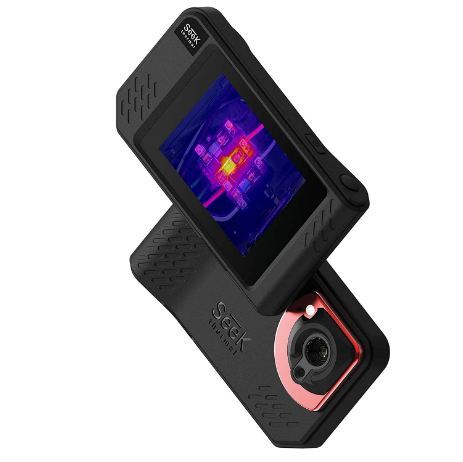
Seek Thermal Shotpro is one of the most advanced thermal cameras for building professionals.
The compact infrared camera features a much higher thermal resolution than other similar models but, unlike other reasonably priced Seek units, it also incorporates visual light.
Key Features
- A large 3.5” color touchscreen boasts a 640x480 resolution and a 320x240 thermal resolution, allowing you to see in clearer detail.
- On-device measurement tools enable you to capture, compile, and analyze photos immediately in the field. You can add temperature boxes and spot measurements on the spot and make time-saving reports. You can also diagnose problems accurately by viewing them in a higher resolution than other similarly-priced cameras.
- SeekFusion technology combines thermal and visible images, so the camera shows exactly what you’re looking at.
- Like the FLIR C5, the Seek Shotpro boasts Wi-Fi streaming (via SeekView) and 4GB memory for capturing stills and videos. If you are in a hurry and don’t want to use the app, you can use the camera’s touchscreen and built-in analysis tools to monitor maximum, minimum, and average temperatures.
- The free SeekView app lets you transfer photos and videos to your smartphone or tablet for in-depth analysis.
- The built-in tripod mount makes it perfect for hard-to-reach areas and fixed monitoring.
- Battery lasts for up to 4 hours of continuous thermal imaging.
- The camera comes with three customizable spot temperatures and three customizable area boxes.
- Eight color palettes and four emissivity presets.
- Automatic indicators for Hi/Low temperature.
- Adjust and lock temperature scan.
Overall
Available at less than $1000, the Seek Thermal Shotpro is perfect for individuals who want a quality thermal camera without spending a lot of money.
Its integrated SeekFusion technology lets you change a live overlay using an on-screen slider, similar to adjusting opacity in Photoshop layers.
The technology also blends visible and thermal images, while Wi-Fi streaming enables you to stream and share photos with your tablet or smartphone.
While the Shotpro doesn’t have the edge-enhancement of the FLIR MSX, its higher thermal resolution means that you won’t really need it.
With on-device tools for editing and analysis and temperature boxes and spot measurements for creating time-saving reports, the Seek Thermal Shotpro allows you to diagnose and fix problems quickly in the field.
However, the device’s software is a bit buggy and might need frequent restarting. It’s also a bit difficult to transfer videos and images by connecting to the app.
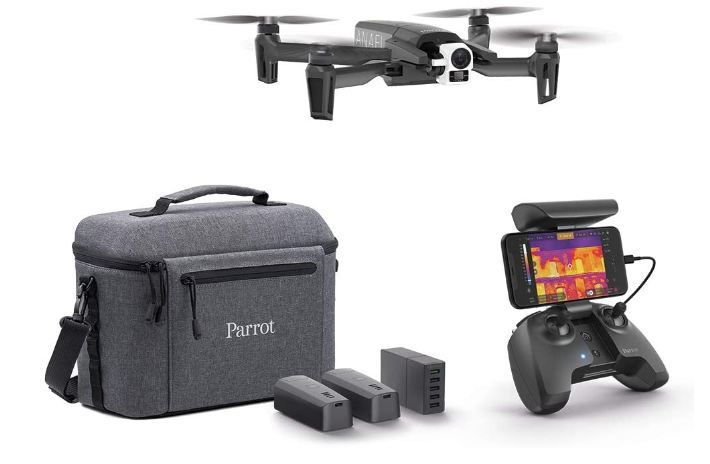
Since one of the most important uses of thermal cameras is identifying people during search-and-rescue operations, it would be wrong if we didn’t include a drone in our list.
If you want a reasonably priced unit, then the Parrot Anafi Thermal, with its incorporated FLIR Lepton 3.5, is the way to go.
Key Features
- The imaging system includes a 21MP CMOS sensor that can capture MP4 videos.
- The Anafi Thermal boasts a 16MP (4608x3456) rectilinear lens with a 75.5o field of view.
- The camera is equipped with high-density 2700mAh batteries.
- The Parrot Skycontroller 3 has a maximum transmission distance of 4 km.
- Due to its unique, lightweight, foldable, and ultra-compact design, you can unfold and operate the Parrot Anafi Thermal within 3 seconds. It’s also equipped with three smart batteries and has a flight time of 25 minutes.
- The Parrot Anafi Thermal ensures that thermal imagery is easily accessible to all. You can use the FreeFlight application to switch from a thermal view to an RGB view or combine the two for a more understandable rendering.
- This model has a maximum working altitude of 4500m above sea level and is compatible with mobile devices with a screen size of up to 10 inches.
- The drone boasts a 180o tilt gimbal for both visible and thermal imagery, allowing it to capture unprecedented shots from unique angles.
- The Parrot Anafi Thermal is incredibly versatile. Construction industry professionals can use drones to identify insulation voids or thermal losses, perform building diagnoses, and collect necessary thermal data. Infrastructure maintenance workers and energy suppliers can identify failures and problems on high voltage power lines or isolate a faulty solar panel in only a couple of minutes. Civil security experts can also remotely identify hot spots and determine the best place for action.
- The 4K and thermal images from the drone make it easier to search for people in isolated areas and do not put the lives of energy services agents at risk. Anafi Thermal also makes it easier to observe, identify, and monitor wildlife species without disturbing them. You can also use the drone to keep an eye on preserved areas and prevent illegal hunting.
Overall
The Parrot Anafi Thermal is a lightweight and compact drone imaging solution that’s extremely efficient and easily accessible to all.
It measures and displays all the cold spots, hot spots, and thermal leaks you can’t see as it flies over different areas.
Boasting a 4K HDR camera and 21MP sensor, the drone visually inspects each frame and captures essential details to provide an accurate picture of the condition of a search area or a structure.
However, the placement of the SD card in the drone is a bit annoying, as you have to first remove the battery to access it.
The batteries in the Anafi Thermal also take a long time to charge, so it’s better to have spare batteries with you if you’re using the drone in a professional capacity.
Thermal Camera Buying Guide
What is a Thermal Camera – and How Does it Work?
A thermal camera is basically a non-contact tool that detects infrared energy and converts it into an image that our eyes can see.
The most important thing to know about a thermal camera is that it doesn’t work as a regular camera.
Both the human eye and traditional daylight cameras work in the same way: once visible light energy hits an object and bounces off it, the detector picks up the reflected light and converts it into a visual image.
On the other hand, thermal cameras use heat rather than visible light to create pictures.
They capture infrared energy and use the collected data to make images through analog or digital video outputs.
All objects release infrared radiation, as it’s one of the ways to transfer heat. The higher the temperature of an object, the more infrared radiation it emits.
To put it simply, a thermal camera detects this radiation and converts it into a visual image, similar to how a night vision device captures invisible infrared light and turns it into an image that we can easily see and interpret.
Uses for Thermal Cameras
Thermal cameras were originally designed for military use in the Korean War, but they have now migrated into other fields and have several uses.
Building & Construction Inspection
Mechanical technicians and building construction workers use thermal cameras to quickly and accurately identify leaks and maintain efficient temperature regulation inside a building.
They can analyze spot faults and structure of a building and identify thermal performance issues in doors, windows, and HVAC equipment.
Electrical maintenance workers also have extensive use of thermal cameras.
Power line technicians use the device to locate parts and joints that are more likely to overheat, as they emit more heat than other sections.
They can help identify loose connections and devices that are close to breaking down as well.
Plus, plumbers use thermal cameras to inspect areas of possible leaks, primarily through pipes and walls.
Since you can easily use thermal cameras at a distance, they are perfect for finding problems in equipment that either poses safety risks to workers or is hard to reach.
Surveillance & Security
Animal and pest management workers have several uses for thermal cameras.
They use the devices to help spot animals and pests on dark roofs, preventing them from climbing up onto them themselves.
They also use thermal cameras to identify potential termite activity and conduct wildlife surveys in a non-intrusive and non-invasive manner.
Thermal imaging is further useful for transport navigation, especially when traveling at night.
For instance, maritime vessels use advanced thermal cameras to clearly see other vessels, obstructions, and people while out at sea.
Cars have also started to incorporate thermal cameras to notify drivers of animals or people beyond their headlights or streetlamps.
Law enforcement agencies and police forces also incorporate thermal cameras into their surveillance gear and use them to locate suspects at night, investigate crime scenes, and conduct search and rescue operations.
These devices are ideal for tactical missions and are better than night-vision cameras because they’re unaffected by bright lights and don’t need any ambient light, as well.
Aerial Inspection (Drones, etc.)
Firefighters use thermal cameras to see through smoke and fog, especially in search-and-rescue missions when they’re looking for people in a dangerous and obscured environment.
Thermal cameras can also help identify spot fires, allowing firefighters to take action before they spread.
You can also use thermal camera drones to inspect photovoltaic systems.
Nowadays, thermal camera drones are used for thermographic inspection of inaccessible electric power lines and buildings as well as for law enforcement jobs.
This technology can also be implemented in research and development, industrial applications, nature observance, and cutting-edge aerial technology.
How to Use a Thermal Camera
Thermal cameras provide accurate thermal data based on different heat signatures.
They convert infrared radiation invisible to the naked eye into visual pictures with varying shades of color representing different heat levels.
For instance, dark red indicates abnormally high temperatures, while blue stands for cooler temperatures.
Thermal imaging results are relatively simple to read and understand, and you can easily identify normal and abnormal temperatures.
Each thermal camera has its own interface, so it’s important to consider the user manual before you start using one.
Some models might be easier to use than others, so it might be a good idea to go through verified user reviews and pick a user-friendly model, especially if you’re just a beginner.
Consumer Uses of Thermal Imagers
While many associate thermal imaging with commercial and industrial settings, the truth is that they can be one of the most versatile tools you can have at home.
Thermal imagers are well-suited for inspecting your home for energy audits, to locate where heat is escaping through leaky windows and doors.
Thermal cameras can also be used for locating wall studs, areas with missing insulation, wet spots in walls and cool spots on a failing stove or oven.
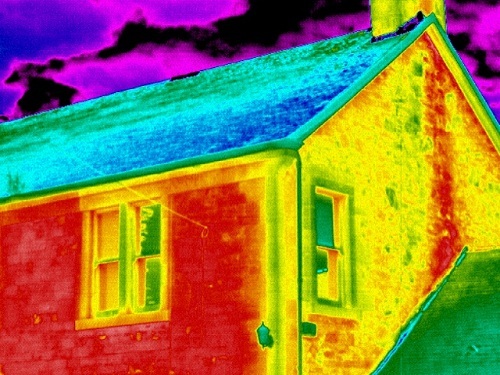
Electrical and fire hazards can be identified using thermal cameras, too, whether it’s an overheated outlet, a short in your wall, or overloaded circuits in your breaker box.
There are many less serious uses for thermal imagers in your home, too. You can use them to check the temperature of almost anything, or anyone, for any use. Check your baby's bottle, the temperature of your beer, the difference in temperature between rooms, and more. The uses are endless.
Thermal imagers with distance capability can also be used for home security or locating a missing animal in the yard, at night.
Industrial Uses of Thermal Imagers
Thermal imagers are a valuable tool utilized in many industries to inspect equipment, to improve efficiency and to ensure safety.
Utility and industrial plants are common places you'll find thermal imaging cameras, due to the amount of electrical work, piping, and machinery that need constant monitoring.
Thermal imagers are like a second set of eyes for many industrial professionals. They can spot bearings going bad, motors about to fail, pumps that need maintenance and issues with circuitry and piping before they fail. Identifying problems like these before they get out of hand averts dangerous and costly incidents.
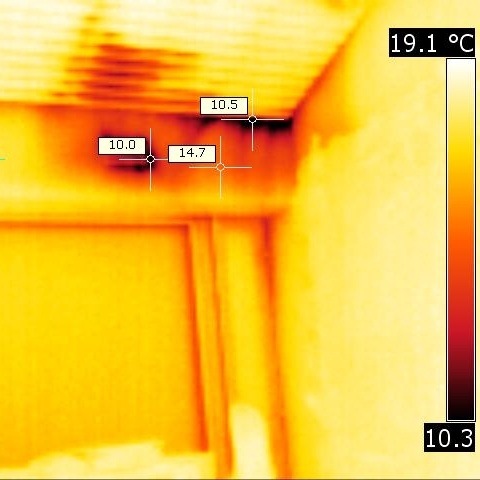
First responders use thermal imaging to locate victims in low light situations, and policemen use thermal imagers to spot dangerous subjects that may be in hiding and to assess a potential threat beyond a door or wall.
Of all industrial uses, however, thermal imaging is most helpful to contractors, building inspectors and home builders. HVAC issues are easy to spot and analyze, while water leaks and damage to a roof can be detected, avoiding more costly repairs or inspection failures, later on down the line.
Pros and Cons: Thermal Camera
A thermal camera is a significant investment, so it’s important to consider whether you need one or not.
In our opinion, the device is extremely useful, especially when used in a professional capacity. However, make sure you compare its pros and cons and make the decision yourself:
Pros
- Thermal cameras provide safer, faster, and more efficient measurements of hard-to-reach objects, such as high-altitude power lines.
- Regular predictive maintenance with thermal cameras helps save money. Since these devices help reduce power outages, fires, and production losses, they help lower costs.
- These cameras help document abnormal heat dispersion and identify air leakages or irregularities in insulation.
- You can use thermal cameras in almost every lighting condition. This means that you won’t have to worry about waiting for peak sunlight hours or a dark evening in an area with no light pollution to use a thermal camera effectively.
- Thermal cameras also help you see through smoke, dust, sand, and fog, making them perfect for unpredictable circumstances. You can also use them to see through leaves, foliage, and thin materials. Although these devices do not offer X-ray vision, they’re still able to identify engine and body heat from a greater distance than normal daylight cameras.
lenses.
Cons
- Most thermal cameras are expensive.
- Images of objects with fluctuating temperatures are difficult to read and interpret.
- Different surface reflections can hinder accurate temperature measurements.
- You cannot use thermal cameras to study underwater objects.
- You cannot see distinct faces with a thermal camera. If you’re using the device for security purposes, you’ll have difficulty identifying any arsonist or trespasser that comes onto your property.
Care and Maintenance: Thermal Camera
It’s essential to clean the lens of your thermal camera, as excess oils and dirt can interfere with the image and measurement accuracy.
Make sure you clean the lens only when it’s absolutely necessary. You don’t need to clean the lens regularly or after every use, but only when there are visible fingerprints or dirt.
You can consult the user manual for proper care and maintenance or follow this cleaning procedure:
1
Gently blow or dust the lens with a lens cleaning brush.
2
Use a commercial lens cleaner with a minimum of 30% isopropyl alcohol or a lens cleaner with 90% isopropyl alcohol.
3
Dampen a lens tissue or cotton ball with the cleaner.
4
Use a rolling motion to wipe the lens, starting from the center and moving to its outer edges.
5
Throw away the lens tissue/cotton ball, and don’t reuse it.
6
Don’t rub the lens dry; only let it air dry.
7
Clean the body with a soft, clean cloth. You can also dampen the cloth and use a mild detergent if needed.
FAQs
How accurate is a thermal camera?
It depends on the quality of the thermal camera, and the type of surface or object being measured.
Thermal cameras with adjustable emissivity (which can greatly affect measurement accuracy) are more accurate. Some professional thermal cameras allow you to adjust other parameters as well like ambient temperature, reflected temperature and atmospheric pressure to achieve more precision.
Thermal cameras with lower thermal sensitivity or NETD will also be more accurate. A camera with 50 mK sensitivity can spot smaller temperature differences compared to one with 100 mK sensitivity.
What is the range of a thermal camera?
Temperature range for most thermal cameras is usually -4F to 572F. The max temperature is lower (200-300F) in cheaper models and higher in high-end professional thermal cameras (1000F or more).
Can a thermal camera see through clothes?
No, it cannot. However, it can identify things on your body that have a high temperature difference such as a gun strapped to your waist or a necklace around your neck.
Do thermal cameras work through walls?
Thermal cameras can see things in the wall such as a water leak, studs or electrical wiring, but cannot see through walls.
That’s because walls are thick enough to block infrared radiation from anything on the other side. The same is true for glass. Because most IR radiation cannot pass through glass, a thermal camera can’t ‘see’ through a house or car window.
Can I use a thermal camera during the day?
Many people confuse thermal cameras for night vision imagers. Night vision technology works only at night.
Thermal cameras, on the other hand, can be used during the day and night. They do not need visible light to function.
How much do thermal cameras cost?
Thermal cameras are a big investment and usually cost $1000 or more. However, lower-quality devices are cheaper, with some being priced as low as $200.
Can a phone double as a thermal camera?
Some phones already have a built-in thermal camera, while some attachments, like the FLIR ONE, can transform your phone into a powerful thermal camera. You can also use a thermal app if you want thermal images on your cell phone or modify your existing phone by removing its IR filter.
Final Verdict: What is the Best Thermal Camera Sold Today?
With such a wide range of models available today, choosing the best thermal camera is next to impossible. Each unit excels in different areas, so make sure you go through all the models reviewed above and choose the one that best suits your needs!
Want To Read This Guide Later?
Enter your email below and we'll send you this buying guide in a .pdf format that works on any device. Great for sharing with colleagues or friends!